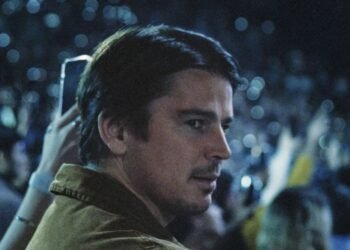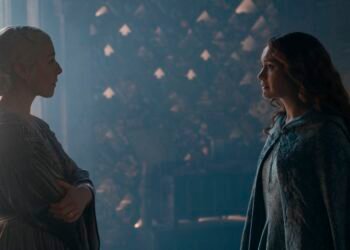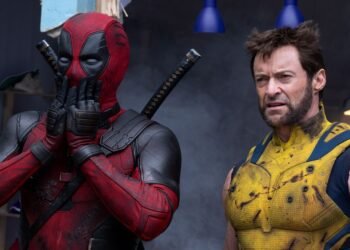This review of The Beast comes from the film’s screenings at the 2023 New York Film Festival.
On paper, the premise of Bertrand Bonello’s new science fiction movie La Bête, or The Beast, seems relatively easy to follow. In 2044, Gabrielle (Léa Seydoux) is on the verge of undergoing a “purification” procedure to purge her DNA of the experiences, emotions, and traumas of her past lives from 2014 and 1910. First, though, she has to relive them in vivid detail.
It’s a time-travel story of sorts, but it begins out of time and outside its own fictional reality, opening with a voice from off screen (Bonello himself) directing Seydoux in an enormous green-screen room. As Seydoux, knife gripped tightly in hand, cowers from some unseen beast, this prologue sets the stage for images and abstract ideas that recur throughout the movie’s various timelines, from the terror of this encounter itself to themes of how simulacrums of reality evolve over time, and how the past becomes pastiche. All this is tied together by the invisible foreboding plaguing Gabrielle across three different lifetimes.
It’s a strange, oblique adaptation of Henry James’ 1903 short story “The Beast in the Jungle,” retaining only the overwhelming dread and depression James’ protagonist John Marcher feels, which prevents him from fully living and embracing romance until it’s far too late. There have been several movie versions over the past decade — a Brazilian one in 2017, a Dutch one in 2019, and an Austrian one released earlier in 2023, which transposes the story’s setting to a nightclub between 1979 and 2004. But rather than copying the core premise of the short story, Bonello’s French- and English-language adaptation uses James’ dense, descriptive prose to weave detailed textures and sensations in each of his timelines.
While the movie’s three settings are nominally connected by the lives Gabrielle has lived, The Beast isn’t concerned with the hows and whys of reincarnation and recollection across time. Instead, it takes a distinctly Bollywood approach to rebirth: So long as the same actors play each version of the character, Bonello assumes the audience will project the necessary connections onto them.
That sense of projection is vital to The Beast, a film whose emotional impact depends on what you bring to it. But the film is never as languid as your average arthouse Rorschach test. Its luxurious 1910 timeline, set amid Parisian aristocracy, sees a married Gabrielle, a musician and dollmaker by trade, meeting a charming, mysterious Englishman, Louis (George MacKay), who reminds her that they once met in Florence and shared a secret many years ago, when they were both different people. It might as well have been a different lifetime. Right from the get-go, this tale of past lives and rebirths unfolds through doublespeak. The literal and metaphorical exist in such close proximity that they’re indecipherable. That linguistic sleight of hand also applies to Louis’ flirtations: Gabrielle asks him whether they spoke French or English in this past encounter. He replies, “We mixed tongues.”
It’s easy to get swept up in their repressed romance, but all the while, Gabrielle speaks of some tragedy that’s set to befall her, like a beast waiting for her in the jungle, ready to annihilate her. With the benefit of hindsight, that might have been a premonition — could she have foreseen the first World War, or perhaps the Great Flood of Paris in 1910? — but this nebulous sense of doom never fades. Not for Gabrielle in 1910, and not for the versions of her who live in 2014 and 2044. By fracturing the story across these three timelines, Bonello places the very anxiety of being alive in a broader historical context. Today, threats of climate change and war aren’t all that different from what Gabrielle would have lived with in the 1910s, a looming possibility of annihilation that both drives and stifles people in their everyday lives.
Some of those anxieties are manifest in the 2044 storyline, in a version of Paris where jobs are all in service of AI, where walking the streets requires airtight gas masks, and where people wear beige and gray and dull their emotional responses in order to become more proficient workers. It’s the film’s only segment shot in a narrow 4:3 aspect ratio (the rest of it is in 1.85:1, closer to an HD television), as if technology had shrunk the borders of human possibility.
For Gabrielle to move up in her career, she must confront — and if she so chooses, erase — the traumas of her past, which she accesses through a spine-chilling method involving a needle in her ear as she floats in a black liquid. This is a process the future timeline’s Louis is strongly considering too, if it means professional mobility. (They cross paths during a career evaluation.) How this recollection technique actually works is a mystery, but it feels both visceral and primordial, and while the two past timelines are technically memories, they aren’t approached with the traditional cinematic hallmarks of flashbacks, like literal flashes, match-cuts, echoes of dialogue, or similar tricks. The flashbacks unfold as vividly as the so-called present; the film’s 2044 scenes aren’t an anchor so much as an oblique framing device to explore tales of art, repression, and violence across the decades.
While the 1910 segments take the form of a straightforward romance, the scenes set in the relative modernity of 2014 Los Angeles are fractured in their construction, and they betray a subtle surrealism. (It isn’t quite David Lynch’s LA, but it’s hardly naturalistic.) Gabrielle is a model and wannabe actress in this life, while Louis is a frustrated incel vlogger who prowls the night in search of women. He leaves an initially amusing but increasingly eerie series of videos that become reminiscent of the manifesto of Elliot Rodger, who went on a misogynistically motivated shooting spree in California in 2014.
As Louis and Gabrielle’s lives tangle, so do several other elements from all three timelines, from secondary characters to familiar lines of dialogue to dolls that become increasingly animated and human across the decades. Eventually, the film’s 2014 chronology builds to a deadly crescendo on par with a tightly wound horror film. This climax grows in heart-pounding intensity, not only through anticipation, but repetition, emphasizing just how close each of us truly is to losing our humanity, perhaps even willingly.
The Beast’s three timelines play with seemingly unmixable genres: a classic period romance, a gripping horror-thriller, and dystopian sci-fi. That places them at a logistical disconnect, but Bonello binds them aesthetically and emotionally. Through his lengthy, thought-provoking close-ups of Gabrielle and Louis in each section, he creates a sense of longing and isolation across time, binding together human experiences of the past, present, and future, and putting them into sharp and chilling context.

Photo: Kinology
And yet the movie feels like it’s constantly pulsating and alive during each and every scene. That’s a form of cinematic self-justification; as the possibility of “purification” looms, so does the idea that each of these experiences, from love and joy to loss and agony, will be lost like tears in the rain. As the Gabrielle of 2044 relives upsetting moments from 1910 and 2014, she’s compelled, by an unseen voice just off screen — most characters in this future are disembodied voices, only semi-human — to not let them affect her, and to dull her senses. But there is, perhaps, nothing more disturbing than the idea that human beings shouldn’t be disturbed by the atrocities around them.
French actor Gaspard Ulliel (Moon Knight) was originally set to play the role of Louis before his death in a skiing accident at age 37. In dedicating The Beast to Ulliel, Bonello creates a framing of tragedy and memory around its very existence, pulling reality into his fictional construct the way he does with his opening green-screen sequence. The movie unfurls in abstract ways, with jagged edits and sudden sounds forming a strange glue for the three timelines, but it constantly invites the real world into its emotional and technological considerations. The Beast doesn’t bother exploring the scientific nuts and bolts of its premise, but in a deconstructive sense, it’s as purely sci-fi as cinema gets. Each image and piece of music binds the past and future together in stirring, thought-provoking ways, turning them both into the now.
In penning such a wide-reaching adaptation, one that runs the entire gamut of human emotion, Bonello crafts a perfect cinematic microcosm of being alive, in all its joys and miseries, on the constant edge of oblivion. In his version of the future, characters trapped by a world that values neither emotion nor experience make frequent trips to clubs that play music from decades prior. One joint keeps changing its theme (including its dress code) from the 1960s to the ’70s and ’80s, reflecting the ways the past is filtered and fractured through the prism of the present. But what tethers even these imitations of eras together is people’s desire to live as their forebears once did, and to break through the surface of each pastiche to find real lived experience, driven by music and movement.
This is also, in essence, an apt description of The Beast. The musical compositions (by Bonello and his daughter Anna Bonello) and the soundtrack, filled with captivating classics, create a rhythmic intensity that binds its disparate stories of love and loneliness into something piercing and complete. The camera follows its characters through hallways and around winding corners until they find each other, in circumstances both exuberant and tragic. All this culminates in one of the most terrifying moments of anguish ever put to film, courtesy of Seydoux’s pained and deeply vulnerable performance, which is sure to burn its way into the audience’s subconscious and live with them long after. It echoes, like an intimate experience from some other lifetime, but one that feels impossible to shake.
Janus/Sideshow acquired The Beast at NYFF and is planning a release soon. Polygon will update this review when release plans are clearer.
























































